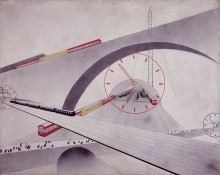Modern Times
12 Mar 2010 - 03 Oct 2011
MODERN TIMES
The Collection. 1900-1945
12 March, 2010 - 3 October, 2011
The true extent of the wealth of artworks owned by the National Gallery is to be revealed as never before. From March 2010 onwards, paintings and sculptures from the classical modernist period up to 1945 will go on display to the public. This will be followed by a second show featuring works from the period after the Second World War.
There are few other museums where history has played as instrumental a role in shaping the collection as it has done in the National Gallery in Berlin. Most damaging of all in the pre-war years was the splintering of the collection by the Nazi campaign against 'Degenerate Art' in 1937. Countless Expressionist masterpieces such as Franz Marc's 'Tower of the Blue Horses' vanished from the collection and are still sorely missed to this day. The most important of these lost key works will be integrated into the great showcase of the collection in March in the form of a 'shadow gallery'. The partition of Germany also manifested itself in the differing strategies adopted in maintaining the collection: while in West Berlin the formal innovations of various avant-garde trends came to the forefront, in the East Berlin National Gallery, the emphasis lay firmly on the art's content. The merger of the two collections resulted in several groups of works complementing each other, as seen in the abstract artist and Bauhaus teacher László Moholy-Nagy, whose work is now juxtaposed with that of Oskar Nerlinger, who uses similar elements in relation with people and machines to illustrate the city, technology and work.
The Collection. 1900-1945
12 March, 2010 - 3 October, 2011
The true extent of the wealth of artworks owned by the National Gallery is to be revealed as never before. From March 2010 onwards, paintings and sculptures from the classical modernist period up to 1945 will go on display to the public. This will be followed by a second show featuring works from the period after the Second World War.
There are few other museums where history has played as instrumental a role in shaping the collection as it has done in the National Gallery in Berlin. Most damaging of all in the pre-war years was the splintering of the collection by the Nazi campaign against 'Degenerate Art' in 1937. Countless Expressionist masterpieces such as Franz Marc's 'Tower of the Blue Horses' vanished from the collection and are still sorely missed to this day. The most important of these lost key works will be integrated into the great showcase of the collection in March in the form of a 'shadow gallery'. The partition of Germany also manifested itself in the differing strategies adopted in maintaining the collection: while in West Berlin the formal innovations of various avant-garde trends came to the forefront, in the East Berlin National Gallery, the emphasis lay firmly on the art's content. The merger of the two collections resulted in several groups of works complementing each other, as seen in the abstract artist and Bauhaus teacher László Moholy-Nagy, whose work is now juxtaposed with that of Oskar Nerlinger, who uses similar elements in relation with people and machines to illustrate the city, technology and work.

